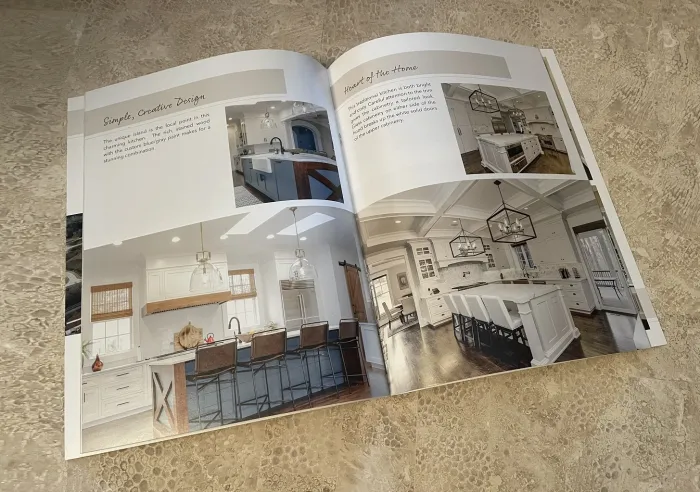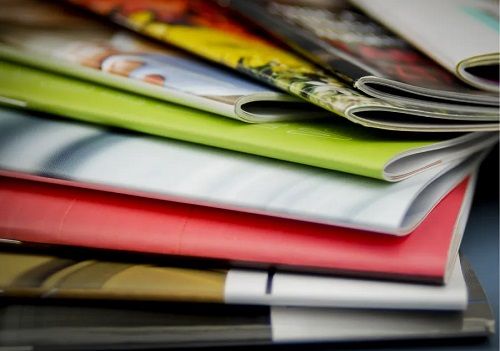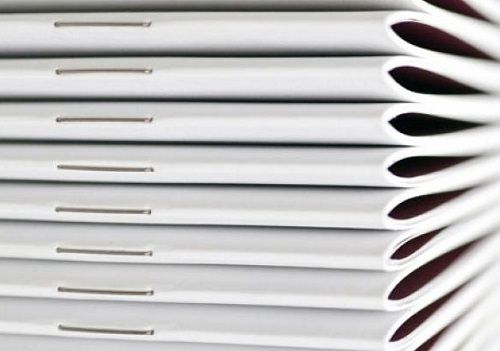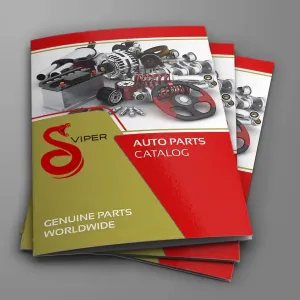Booklet Printing: 7 Fast Facts about Saddle Stitch Booklets

estimated reading time: 6 minutes
Saddle Stitched Booklets
Saddle Stitching is one of the most popular methods for
creating custom booklets. This binding style uses wire staples to secure the
pages and cover together.
Though it has a relatively simple construction process, the Saddle-Stitch
binding method produces professional looking booklets that are well-functioning
and reasonably priced.
Here are seven quick facts to bolster your understanding
of Saddle Stitched booklets…
1. The page count of a Saddle Stitch Booklet must be a multiple of 4
If you examine any saddle-stitched booklet, you will see
that it is constructed from folded sheets of paper. As such, each folded sheet
forms 4 pages of the finished booklet.
Of course, this means the page count of every saddle-stitched
booklet must be a multiple of 4. For example, an 8-page booklet, a 36-page
booklet, and a 60-page booklet can all be saddle stitched.
However, a 10-page booklet, a 21-page booklet, or a 58-page
booklet cannot be bound with the saddle-stitch method. This is because these
page counts are not multiples of 4. In order to saddle-stitch these booklets,
pages will have to be added or removed until the count is a multiple of 4. By
the way, a blank page still counts as a page.

2. Saddle Stitch binding works best for lower page counts
After being printed, the sheets used to create the cover and
pages of a saddle-stitched booklet are partially folded and then draped one at
a time over a saddle-like apparatus. As the sheets fall into place, their fold
lines nest together.
Once all the folded sheets have fallen into place, they are
conveyed to a stapling station where wire staples penetrate through the fold
lines of the outer cover and all interior pages. The staples are cinched closed
after penetrating the innermost sheet of the booklet.
Because a wire staple has a limit to the number of paper sheets
it can secure, the page count of a saddle-stitch booklet also has an upper
limit. Saddle-Stitch binding equipment can usually join up to 30 sheets of
paper. Since each sheet creates 4 pages, this translates to a maximum of 120
pages.
However, this is more of a theoretical maximum than a practical maximum because 120 pages will result in a "puffy" booklet that may not lie very flat. Of course it is a matter of personal preference, but for a saddle-stitched booklet to lie relatively flat the recommended page count is 60 pages or less.
3. Saddle Stitch binding can be used for a wide range of projects
Saddle-stitching is one of the most popular binding styles
because it works for so many types of multi-page documents.
Common examples of saddle-stitch projects include
instruction manuals, installation and assembly guides, product and price catalogs,
handbooks, comic books, coloring books, activity books, event programs,
magazines, journals, directories, and workbooks.
In addition to books and booklets, other documents that are
frequently bound with the saddle stitch method include brochures, promotional
mailers, newsletters, bulletins, and multi-page wall calendars.
It is also important to note that saddle stitch binding works
well with a wide range of book dimensions, from pocket-size books to oversize
books. Plus, saddle stitching is suitable for short, medium, or long production
runs.
4. Saddle Stitching is the most economical binding option
Compared to other binding styles, saddle stitching has fewer
production steps. Hence, its relative simplicity helps to keep the cost low. In
fact, saddle-stitching is the cheapest binding method available. Saddle-stitching
also offers a quicker turnaround time than most other binding types.
In addition, the saddle-stitch binding method adds minimal
weight or bulk to the printed sheets. This can help minimize transit costs.

5. The Self-Cover option makes Saddle Stitched booklets an even better bargain
Most books and booklets use a heavier paper stock for the cover than what is used for the inside pages. However, saddle-stitched booklets can also be made with the "Self-Cover" option.
A self-cover booklet means
the cover is made with the same type and weight of paper as the pages. In other
words, the entire booklet is printed on the exact same paper stock.
The cover could be a lighter weight to match the pages, or
the pages could be a heavier weight to match the cover. Either way, the
self-cover option provides some cost savings because the entire book can be
printed and assembled all at once, as opposed to requiring two separate production
runs for the cover and pages.
6. Saddle Stitched booklets incur a phenomenon known as Page Creep
Page Creep, also known as Binder's Creep, refers to the
incremental shifting of pages that occurs when binding a saddle-stitched booklet.
Because saddle-stitched booklets are made from folded sheets
that are nested together, each folded sheet added to the booklet will extend a
little bit further out than the folded sheet preceding it. How far each sheet
extends is based on the thickness of the paper being used to create the
booklet. Also, creep becomes more noticeable as the page count increases.
Even though the pages of a saddle-stitched booklet will be
gradually pushed outward and may produce an uneven "shingled" look
along the edge where the pages open, a final trimming will even up the outer
edge of the pages.
However, due to the creep, trimming the outer edge removes
more paper from the innermost sheets than it does from the outermost sheets. This
causes the outer margins of the innermost pages to become narrower than the
outer margins of the outermost pages. As a result, the content printed on the
innermost pages will end up closer to the open edge of the book than originally
intended.
Though it is important to be familiar with the concept of
creep, it isn't something to stress about. Your printer's prepress department
will use imposition software to adjust the page margins for creep before any
printing takes place. This will ensure your booklet remains aesthetically
pleasing.
7. Most printers prefer you don't submit Saddle Stitch artwork files as "Spreads"
As already mentioned, saddle stitched booklets are made from
folded sheets nested together and each folded sheet creates 4 pages of the
booklet. If you were to remove the staples from a saddle-stitched booklet, you
would see that the pages appearing side-by-side in the finished book are
not actually printed next to each other on the same sheet of paper (the only
exception to this is the booklet's center page spread, where the two opposing
pages are printed on the same sheet).
Hence, submitting a page file set up in Reader Spreads (where
the pages are paired together based on how they will appear in the finished
book) is not the way most printing companies prefer to receive the artwork. This
is because the pages will not actually print in a configuration that matches
the Reader Spreads. For example, Reader Spreads will display pages 4 and 5 side
by side. But depending on the page count of the booklet, page 4 may actually
print side by side with page 9, page 57, or some other page.
Submitting the pages as Reader Spreads will force your
printer to electronically separate the pages and then reposition them in the
proper place. To avoid these extra steps, your printer would prefer you submit your page artwork file with each
individual page laid out as 1-up (not as 2-up spreads) in the exact order the
pages will appear in the booklet. This way your printer's prepress department
can impose the pages in the configuration that best matches their printing
equipment.
Another layout option is Printer Spreads. Some printers may
be okay with Printer Spreads but most will probably still prefer a page layout file
with the pages configured as 1-up and arranged in the exact order they will appear in the booklet. So, to prevent delays and headaches
for everyone involved, it is always better to check with your printer
beforehand to see which layout format they actually prefer.
Are you looking for affordable Booklet Printing?
If you have an upcoming project for Saddle Stitched
booklets, be sure to get in touch with Color Vision Printing. We've been
printing and binding all types of books and booklets for decades. In addition
to saddle-stitching, we offer perfect binding, spiral coil binding, comb
binding, wire-o, ringed binder sets, and more.
So if you are looking for quality printing and binding at a
reasonable cost, give us a call at 800-543-6299 to discuss your project. Or,
use our simple Quote Request form to send us your specifications and
we will be happy to email a quote to you.
As always, we look forward to assisting you!
Related Articles

Booklet Catalogs: Why is this Catalog Format so Popular?
Read This Article

Creating a Comic Book? Here’s some Advice from a Printer
Read This Article

Perfect Binding vs PUR Binding: What is the Difference?
Read This Article

Perfect Bound Book Printing: Tips for getting the Best Value
Read This Article